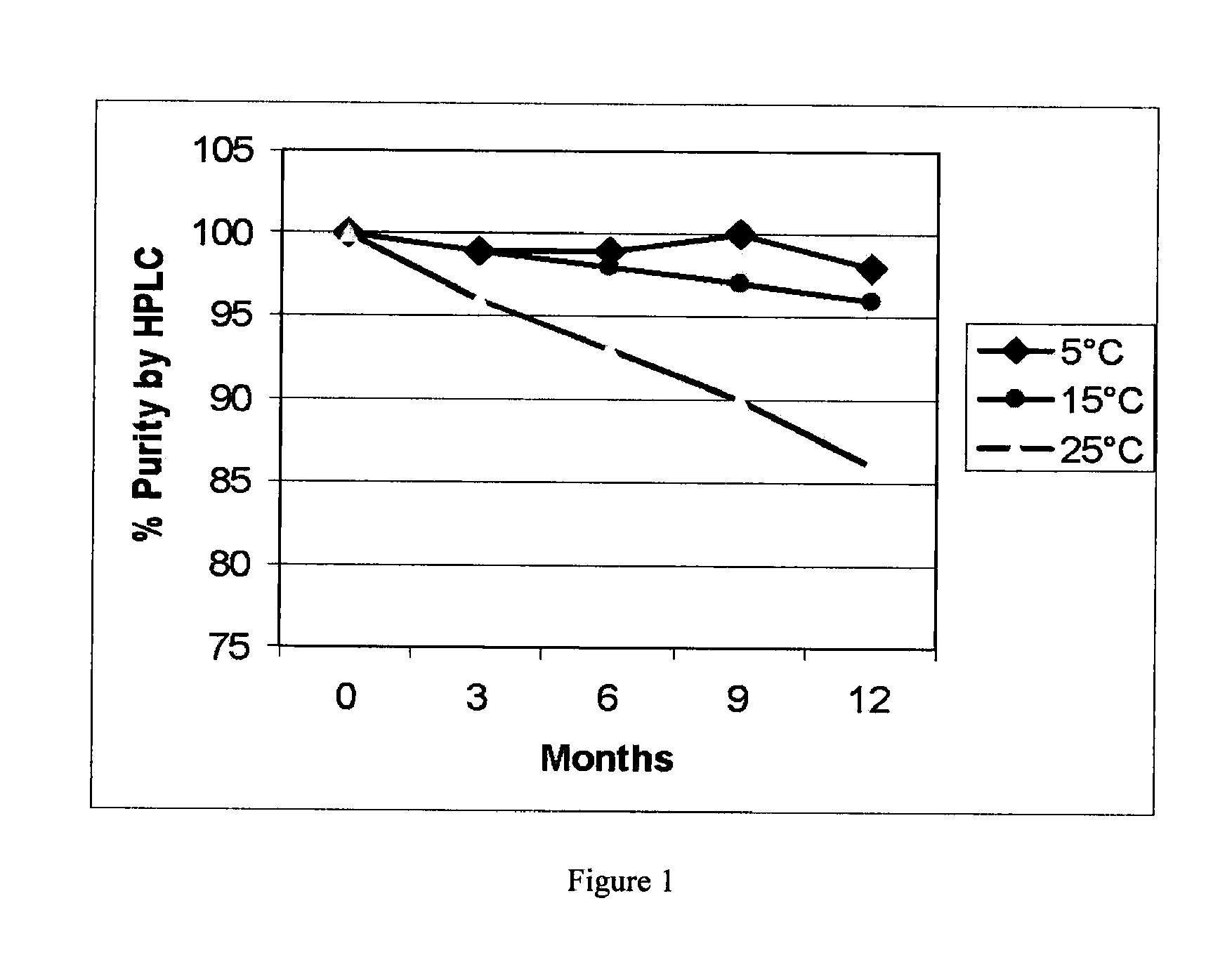Zwitterionic buffered acidic peptide and protein formulations
- Summary
- Abstract
- Description
- Claims
- Application Information
AI Technical Summary
Benefits of technology
Problems solved by technology
Method used
Image
Examples
example 1
Aqueous Formulations of Octreotide
[0051]This example illustrates preparation and characterization of aqueous formulations including octreotide. Octreotide is an octapeptide that mimics natural somatostatin pharmacologically, however is a more potent inhibitor than natural somatostatin.
[0052]Two developmental aqueous formulations of octreotide were prepared. Formulation A was prepared with a pH of 4.0 and includes 10 mM aqueous glycine buffer solution containing 0.5% mannitol, 1 mg / mL octreotide and 0.125% dodecyl-maltoside. Formulation B was prepared with a pH of 4.5 and includes 10 mM aqueous glycine buffer solution, 0.18% dodecyl-maltoside, and 0.1% disodium EDTA. Each formulation was prepared and filled into glass vials with rubber closures. The formulations were maintained for timed intervals at −20, 5, 25, and 40° C. and tested for appearance, pH, octreotide potency and octreotide percent purity.
[0053]The octreotide potency and percent purity determinations were determined by H...
example 2
Aqueous Formulations of Octreotide
[0055]This example shows the perturbation of nasal mucosal pH during nasal administration of various types of buffered compositions.
[0056]Nasal lavage fluid was collected by spraying five successive 100 μL aliquots of sterile water (wfi) for injection into a single nasal cavity and immediately collecting the runoff out of the nasal cavity into a glass test tube held immediately below the naris. Samples from a single volunteer were collected no more frequently than once an hour, which allows for four normal mucociliary clearance half-times of 15 minutes each to allow reestablishment of the normal nasal mucosal secretions. Approximately 300 μL of lavage fluid was collected each time. To 300 μL aliquots of nasal lavage fluid in a glass test tube, was added 90 μL of buffer. All buffers were prepared in sterile water for injection containing 0.5% mannitol and 0.15% dodecyl-maltoside, with and without 0.1% EDTA. After gentle swirling, the pH of the result...
example 3
Aqueous Formulations of Glucagon
[0057]Sterile glucagon injection drug product samples were prepared by aseptic processing at 5 mg / mL and 10 mg / mL in aqueous 30 mM glycine buffer solution, pH 3.0 to pH 4.5 with 0.125% dodecyl-beta-D-maltoside as antimicrobial preservative. The samples were stored in 5-mL glass vials with bromobutyl rubber closures at 5, 15 and 25 degrees C. Glucagon working reference standard solutions were prepared at 7.5 mg / mL in pH 4.0, 30 mM glycine buffer with 0.125% dodecyl-beta-D-maltoside as antimicrobial preservative. Purity was determined by reverse phase (RP) HPLC in 0.1% TFA using a linear gradient of acetonitrile on a Perkin Elmer Series 200 UV / Vis HPLC System™ equipped with an Aquapore™ RP 300 column (4.6×250 mm) at room temperature and at a flow rate of 1 ml / min. The elution was monitored by absorbance at 214 nm. Purity was determined from the ratio of the area under the peak for each sample compared to the area under the peak for the glucagon control ...
PUM
| Property | Measurement | Unit |
|---|---|---|
| Temperature | aaaaa | aaaaa |
| Temperature | aaaaa | aaaaa |
| Fraction | aaaaa | aaaaa |
Abstract
Description
Claims
Application Information
 Login to View More
Login to View More - R&D
- Intellectual Property
- Life Sciences
- Materials
- Tech Scout
- Unparalleled Data Quality
- Higher Quality Content
- 60% Fewer Hallucinations
Browse by: Latest US Patents, China's latest patents, Technical Efficacy Thesaurus, Application Domain, Technology Topic, Popular Technical Reports.
© 2025 PatSnap. All rights reserved.Legal|Privacy policy|Modern Slavery Act Transparency Statement|Sitemap|About US| Contact US: help@patsnap.com

